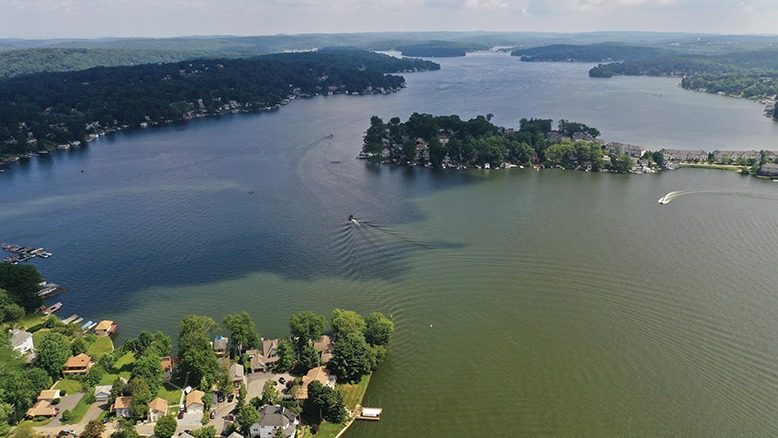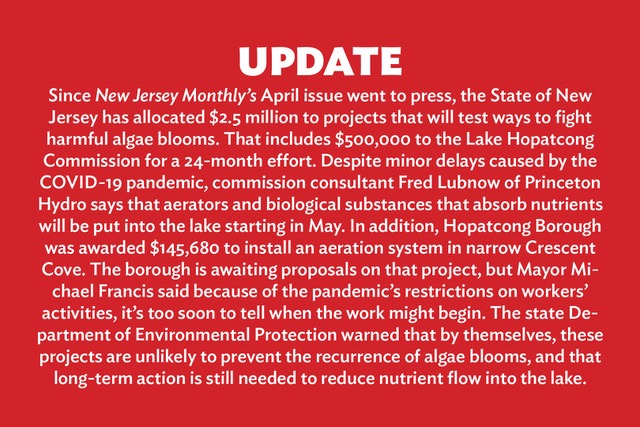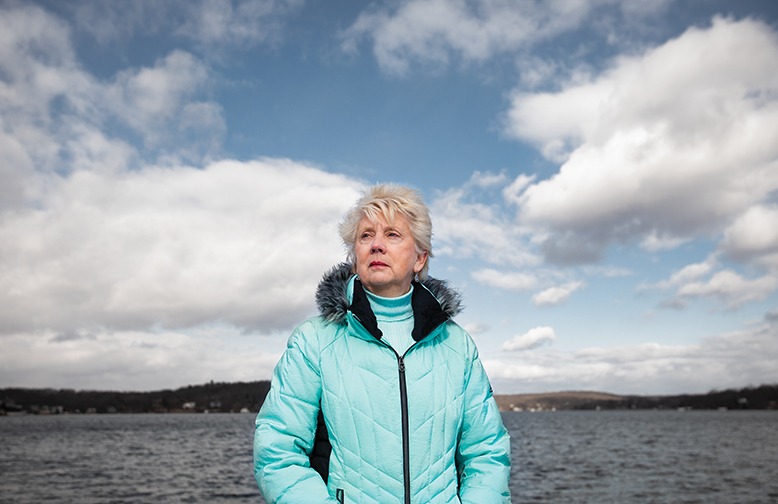

In a lifetime on Lake Hopatcong, Doreen Chaplin has often looked to the lake to decide how she’ll spend the day. If it’s breezy, she sails. If it’s calm, she water-skis. If it’s cool, she fishes. If it’s warm, she swims, slicing and kicking through a mile’s worth of water.
Until last summer. A thick mat of blue-green algae spread relentlessly over the lake, after heavy spring rains washed unwanted nutrients into the water and unusually warm temperatures created optimal conditions for algae proliferation. In late June, the New Jersey Department of Environmental Protection (DEP) warned the public to avoid exposure to the water or risk rashes and other health issues.
“The lake was sick, and I felt helpless to do anything,” says Chaplin, a resident of Mount Arlington, one of four towns bordering the lake.
[RELATED: Rutgers Professor On What Our Trash Reveals About Us]

Doreen Chaplin fears not enough is being done to prevent another Lake Hopatcong algae bloom. “I’m really apprehensive about this summer,” says the Mount Arlington resident. Photo by Joe Polillio
Now, the state and the towns are looking at ways to prevent the return of blue-green algae—more precisely, cyanobacteria—this summer. Plans include expanding sewer lines, aerating coves and installing devices to suck up the excess nutrients that can promote algae growth.
But many people who love the lake—residents, business owners and elected officials—worry that the response won’t be quick enough or extensive enough to keep Lake Hopatcong healthy for this summer and beyond.
The stakes are high for businesses around the lake, which saw revenues plummet by 40–50 percent or more last summer.
“Devastating” is how Steve Halperin, owner of the Lakeview Marina in Jefferson, describes last summer’s crisis.
Another bad summer could spell the end for many lake-based businesses, says Eric Wilsusen, mayor of Jefferson Township.
“They survived one year,” says Wilsusen. “They’re not going to survive two.”
The weather may not give the lake a break. David Robinson, New Jersey’s state climatologist, doesn’t like to forecast, but the trend line over 10 seasons points to high temperatures this year.
“Will this summer be amongst the warmest? Odds are beginning to favor that,” Robinson says. (However, a dry spring could help head off harmful algae blooms.)
The state announced in the fall that it would award $13.5 million in grants for sewer upgrades; treatment and prevention demonstration projects; and scientific evaluation of proposed projects to fight algae blooms on Lake Hopatcong and other bodies of water affected last summer, including Greenwood Lake and Spruce Run Reservoir. The DEP is reviewing several proposals for that funding.
Lake Hopatcong is 9 miles long, but its profile is so jagged and full of coves and inlets that it totals 45 miles of shoreline, with about 2,000 lakefront properties and 2,200 private docks.
Created by damming two ponds in the 1830s, the lake became a source of ice for city dwellers in nearby Newark, New York and other municipalities. When passenger trains arrived in the 1880s, the lake became a summer getaway.
The spread of suburbia turned the area into a year-round community, with properties that range from former vacation bungalows to newer luxury homes. About 65,000 people live in the four lakeside municipalities—Mount Arlington, Jefferson and Roxbury in Morris County and Hopatcong in Sussex County—although most don’t live on the water. The lake is owned by the state, and there are a few public parks on the shoreline, including Hopatcong State Park, but access to the water is mostly through private docks, marinas, and boat and swim clubs.
The lost season
On a typical summer weekend, hundreds of boaters take to the water. But last summer, the lake was often empty, even on the brightest weekends.
That hit local businesses hard—especially those that rely on day trippers.
Jeff Burr has offered hydroflights at Fly High Watersports on Lake Hopatcong since 2013. Hydroflight uses water jets to propel participants into the air.
But Fly High’s business was “pretty much nonexistent” last summer, Burr says. He hopes to open this year, but worries about another algae bloom.
“It’s heartbreaking,” he says. “You put all this time and effort and love and passion into it. I want to keep doing it.”
Halperin, of Lakeview Marina, says July was really bad; August picked up, but business was off by about half.

Ray Fernandez says boat rentals at his Bridge Marina dropped sharply amid news reports of last summer’s algae warnings. Longtime customers, he notes, were less alarmed. Photo by Joe Polillio
Ray Fernandez, who owns the nearby Bridge Marina, says his revenues were also down, though less dramatically. Bridge’s rental business took the biggest hit. All 12 of the marina’s rental boats were booked far in advance for the July 4 weekend. Then the state issued the algae warnings.
“Everybody canceled,” says Fernandez. “They read the headlines; they’re not going to come.”
Bridge also sells and services boats and runs a subscription club, which gives members the right to use a boat. Those customers were more willing to go on the water because they generally have a longer history on the lake and have seen algae blooms before, says Fernandez.
Hopatcong Mayor Michael Francis confirms that businesses around the lake experienced a significant drop off. Some places, like Pavinci’s restaurant, were down more than 40 percent.
Statewide problem
New Jersey began aggressively monitoring for harmful algae blooms statewide in 2017, setting up protocols on when to post warnings and advisories, and when to close beaches, says DEP spokesman Lawrence Hajna.
The state issued last summer’s advisory for Lake Hopatcong after high levels of cyanobacteria, a naturally occurring microscopic organism that resembles algae, were found. By late summer, parts of the lake were declared safe, but as late as September 20 about 40 percent of the lake was still under an advisory. It wasn’t completely reopened until November.
As New Jersey’s largest lake, Lake Hopatcong drew the most attention, but the state DEP confirmed it detected harmful algae on 39 bodies of water last year. By February, several months after Lake Hopatcong was deemed safe—and despite winter temperatures—six sites still had algae blooms, according to the DEP, including Spruce Run Reservoir and Sunset Lake in Asbury Park.
About 30 percent of people are allergic to cyanobacteria, which can cause rashes, gastroenteritis, respiratory irritation and eye irritation, according to the DEP. The bacteria is especially toxic for dogs and other pets. Harmful algae blooms can also produce more hazardous cyanotoxins, which can cause serious liver and neurological problems.

Environmental scientist Fred Lubnow, of Princeton Hydro, uses a Van Dorn water-sampling device to help identify solutions for different sections of the lake. Photo by Joe Polillio
The DEP is reviewing several proposals for projects that could make a difference at Lake Hopatcong this summer, Hajna says. None had been announced as New Jersey Monthly went to press. According to Fred Lubnow, director of aquatics at Princeton Hydro, an ecological engineering firm, possibilities include flotation balls made of nutrient-absorbing wood materials, sonic waves to disrupt algae growth, and the aeration of stagnant coves with nano bubbles. A clay-based product that reduces phosphates and the addition of eco-friendly oxidizers are also possibilities, Lubnow says.
It’s good to have a menu of options, given the lake’s intricate topography, says Lubnow, who consults for the Lake Hopatcong Commission, the independent state agency that works to conserve and improve the lake. “There are all the bays and coves and nooks and crannies, so we need different approaches.”
The town of Hopatcong has two pending projects, both focusing on Crescent Cove, a long, narrow inlet where the water circulates poorly, leading to one of the most severe algae problems on the lake last summer. The town hopes to receive state funding for one of the projects, an aeration system for the cove. Residents along the cove recently approved the second project, which involves hooking up about 40 homes to existing sewer lines. The homeowners would pay for their hookups with financial help from the state.
Over the long term, experts call for pricier structural changes, such as transitioning more properties from septic tanks to sewers and mitigating rainwater runoff through the use of new, permeable materials for roads and other paved surfaces.
Runoff from homes, lawns, septic tanks, roads and even a quarry is a significant issue because of the rocky terrain near the lake. That runoff leaches nutrients into the water that, in turn, feed the algae blooms. It doesn’t help that the lake’s surface temperature has risen over the past 30 years.
Some solutions are available, says Robinson, the climatologist, such as limiting fertilizers that are loaded with phosphorus, which fuels the growth of plants and algae.
Apprehension & optimism
Around the lake, opinions differ about the proposals circulating this spring.
Hopatcong resident Fred Steinbaum, 77, a retired medical oncologist and avid water-skier, says the likely funding is too small to make a difference. “They don’t allow us to do what’s necessary for the lake, especially in this era of algae blooms,” he says as he stands on his deck, gazing at the lake’s glittering surface. The state, he says, has woefully underfunded lake maintenance, such as cleaning storm drains and ridding the water of weeds, for years.
“We need support and we’re not getting it,” says Steinbaum, a member of the Lake Hopatcong Commission. Steinbaum’s family bought lakefront property in 1946; he started dating his future wife during a summer romance at the lake when they were both teens.
Chaplin also fears not enough is being done. “I’m really apprehensive about this summer,” says the defense consultant and retired program manager for the U.S. Army’s Picatinny Arsenal in Rockaway.
Others are hopeful that the weather will be more cooperative or the preventive actions will head off trouble—or both.
Gary Whitman, a Montville business investor who has a house on Lake Hopatcong and is a partner in Stone Water, a lakefront restaurant, says the recent attention and committed investments to the lake are a step in the right direction.
“If there are six projects, that’s six more than were going on in the last five years,” Whitman says. The algae, he adds, may be the catalyst for a turnaround, similar to what happened when medical waste washed up on the state’s ocean beaches.
“Many years ago, there were many problems on the Jersey Shore,” Whitman says. “It was almost like one day someone decided, ‘We’re going to put an end to this.’ Now we rarely hear of major issues on the Shore.”
Tony Noriega, a Re/Max real estate agent who has been selling lake properties for 16 years, believes that algae blooms are not destined to become an annual problem.
“It’s sporadic, and I think people know that,” he says.
What’s his outlook for this summer?
“I’m hoping there’s not a lot of rain,” says Noriega, who lives in a lakefront house. “I think we’re okay as long as the weather is normal.”
Real estate agents say that the first reports of the algae bloom scared off home buyers at the beginning of last summer, but as the summer wore on and the algae situation began to improve, buyers seemed to become less fearful.
False alarm?
The state issued last summer’s advisory based on stringent standards for exposure to the cyanobacteria—standards that are stricter than other states. At Greenwood Lake, for example, the New Jersey DEP issued safety alerts for the Garden State’s side of the lake, while the same water on the other side of the lake was considered okay by New York.
“Most states would not have applied the same standards that we did,” complains Joseph Pennacchio, a Republican state senator from Montville. At the same time, he criticizes the state for being too slow to take action to remediate the problem last summer.
The DEP says that strict standards are essential because of the sometimes toxic risk of cyanobacteria. “We think it’s better to be proactive,” says Hajna, the DEP spokesman.
Still, state officials said last fall that they might adjust their response to algae blooms, possibly by using an incremental scale to measure the algae. That would give users a sense of different risk levels.
Some critics accused the state of sounding the algae alarm to increase support for proposed stormwater utilities, which are local authorities that could be established to assess fees on property owners based on rainwater runoff. These critics mock the potential fees as a “rain tax.” The state denies any link.
With signs on major highways last summer warning that swimming was banned at the state park, many New Jerseyans apparently thought the lake itself was off limits, though boating was still possible if contact with the water was avoided.
“It really hurt activity on the lake,” says Bela Szigethy, who, with his wife, has a summer house on the lake and is co-owner of a New York private equity firm. Szigethy is also one of the founders of the nonprofit Lake Hopatcong Foundation. He and his wife own more than half a dozen businesses around Lake Hopatcong, including the Miss Lotta cruise boat, a mini-golf course, the Main Lake Market and two restaurants, the Windlass and Alice’s.
Szigethy is one of several lake users who say they went boating, water-skiing and even swimming during the algae bloom, with no ill effects.
“People were still living their lives on the lake,” he says. “Life did not end.”
Steinbaum echoes that attitude. “We decided, the heck with it, we are going to ski anyway,” he says. “We’re kind of addicted.” Steinbaum had no known health effects, although he says two of his three grandsons refused to take that risk.
State and local health officials did not monitor rashes or other health problems tied to the cyanobacteria, so it’s impossible to say how many people were affected.
Raising awareness
Many residents and elected officials say the lake has been neglected for too long. They complain that, while the state urges sewers for lakeside properties, it hasn’t even connected the 163-acre Hopatcong State Park to the sewer system. In the wake of the algae blooms, state officials recently renewed their commitment to do just that.
Two of the lake towns—Mount Arlington and Roxbury—have sewer systems. Hopatcong’s 8,000 households include about 3,000 with sewers, says Francis, the borough’s mayor.
Jefferson relies on septic systems. In 2002, the township got an estimate of $65 million to install sewers, a price tag that would surely be higher now, Wilsusen says.
“Unless there’s significant money from the state or federal government, that project is never going to get off the ground,” he adds.
Critics also complain that the Lake Hopatcong Commission went years without funding until it received an annual $500,000 from the state for the last two years. The lack of funding, they say, meant not enough maintenance work was done to keep the lake healthy, such as cleaning out storm drains and controlling weeds.
“The state support of the Jersey Shore is amazing—Lake Hopatcong, not so much,” says Fernandez, the marina owner. “It’s almost an afterthought. It’s just frustrating.”
Jessica Murphy, president of the Lake Hopatcong Foundation, says that as painful as it was, last year’s crisis raised awareness about environmental challenges at the lake, and not just on the governmental level. She says residents are changing their plantings along the waterfront, as well as their use of fertilizers, to reduce the amount of nutrients washed into the water.
“We all look back on 2019 with a fair amount of heartbreak,” Murphy says. “But I think the lake will be healthier in the long run because of the way people, governments and organizations like ours have responded to it.”
Or in Chaplin’s words: “The lake has been a constant source of joy, and no one has had to worry about it. We need to worry about it now.”
Patricia Alex and Kathleen Lynn are New Jersey–based writers and editors. Both formerly worked for The Record in Bergen County.



